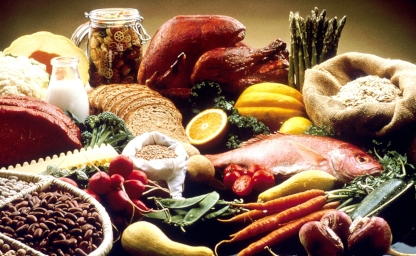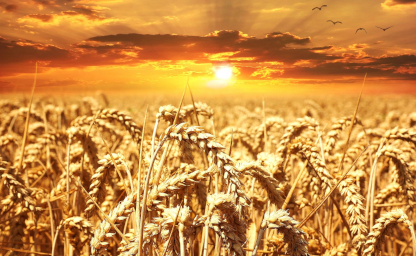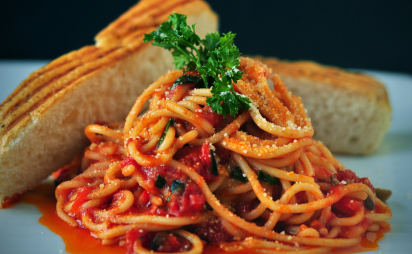Milk Alternatives & Daily Calcium Requirements

This page provides a list of foods that contain the necessary
calcium to maintain a healthy diet for kids and adults especially
those who have a milk free diet.
Milk Alternatives
Milk is rich in protein, calcium and vitamins A and B and it
is important to insure inadequate intake of these elements when
on an dairy-free diet. Sardines are rich in calcium, Soya is rich
in protein, and other foods of importance in a dairy-free diet are
potatoes, vegetable oil and fish. Cod liver oil or fish oils are
rich in vitamin A. Calcium is found in sardines, watercress, figs,
rhubarb, almonds and other nuts. Fresh fruit and vegetables are
a good source and vitamins and minerals (especially important for
children for the formation of strong, healthy teeth and bones).

There are a number of other milks that are available that may
be substituted for cow's milk when baking or cooking. The type of
substitute used will depend on the type of food it is used for.
Soya milk is a popular alternative to cow's milk.
Rice milk is good for drinking and putting on cereal. It can
also be used when baking or as a thickening agent. In some recipes
water, broth, or juice can be substituted for the cow's milk. Sometimes,
a milk allergic person can use goat's milk or soy milk. Both of
these milks, however, are also very allergenic. In fact, most people
allergic to cow's milk are also allergic to goat's milk.
Persons with lactose intolerance should only use milk if treated
with Lactase Enzyme liquid and should never use untreated goat's
milk as it also contains lactose. Lactose is present in all animal's
milk.
Calcium Requirements
Calcium is essential for the growth and repair of bones throughout
life. In the middle and later years, a shortage of calcium may lead
to thin, fragile bones that break easily (a condition called osteoporosis).
The UK Department of Health recommended Reference Nutrient Intake
(RNI) for calcium is as follows. The RNI is a daily amount that
is enough or more than enough for 97% of people.
Daily Recommended Calcium Intake mg/day (UK)
|
Age / Sex
|
Calcium Requirements
|
| Infants & children, depending on age |
350-550 |
| Teenage Girls |
800 |
|
Teenage Boys
|
1000
|
| Adult Man & Woman |
700 |
| Breast-feeding woman |
extra 550 |
Calcium in Food
The table below provides a list of food that contains calcium
and its quantity
| Type of food |
Calcium Content |
| Broccoli (cooked 1 Cup) |
94-177mg |
| Chinese Cabbage (cooked 1 cup) |
158mg |
| Collard Greens (cooked 1 cup) |
148-357mg |
| Kale (cooked 1 cup) |
94-179mg |
| Oysters (raw 1 cup) |
226mg |
| Salmon canned with bones |
167mg |
| Sardines 100g |
371mg |
| Shrimp canned 100g |
98mg |
| Molasses 2 tbsp. |
274mg |
| Tofu processed with calcium salts,
100g |
225mg |
| Parsley 50g |
100mg |
| Dried figs 40g |
100mg |
| Almonds 42g |
100mg |
| Brazil nuts 60g |
100mg |
 Some
vegetables that are high in calcium (Swiss chard, spinach, and rhubarb,
for instance) are not listed in the table above because the body
cannot use their calcium content. They contain substances called
oxalates, which stop calcium absorption. Calcium is absorbed and
used only when there is enough vitamin D in the body. A balanced
diet should provide an adequate supply of vitamin D. Sources of
vitamin D include eggs and liver. However, sunlight helps the body
naturally absorb or synthesize vitamin D, and with enough exposure
to the sun, food sources may not be necessary. Some people with
lactose intolerance may think they are not getting enough calcium
and vitamin D in their diet. Consultation with a doctor or dietician
may be helpful in deciding whether any dietary supplements are needed.
Taking vitamins or minerals of the wrong kind or in the wrong amounts
can be harmful. A dietician can help in planning meals that will
provide the most nutrients with the least chance of causing discomfort.
Some
vegetables that are high in calcium (Swiss chard, spinach, and rhubarb,
for instance) are not listed in the table above because the body
cannot use their calcium content. They contain substances called
oxalates, which stop calcium absorption. Calcium is absorbed and
used only when there is enough vitamin D in the body. A balanced
diet should provide an adequate supply of vitamin D. Sources of
vitamin D include eggs and liver. However, sunlight helps the body
naturally absorb or synthesize vitamin D, and with enough exposure
to the sun, food sources may not be necessary. Some people with
lactose intolerance may think they are not getting enough calcium
and vitamin D in their diet. Consultation with a doctor or dietician
may be helpful in deciding whether any dietary supplements are needed.
Taking vitamins or minerals of the wrong kind or in the wrong amounts
can be harmful. A dietician can help in planning meals that will
provide the most nutrients with the least chance of causing discomfort.
Milk substitutes for cooking
There are a number of other milks that are available that may
be substituted for cow's milk when baking or cooking. The type of
substitute used will depend on the type of food it is used for.
Rice milk is good for drinking and putting on cereal. It can also
be used when baking or as a thickening agent. In some recipes water,
broth, or juice can be substituted for the cow's milk. Sometimes,
a milk allergic person can use goat's milk or soy milk. Both of
these milks, however, are also very allergenic.

Food & Lactose Intolerance
Food intolerance is the inability to
completely break down food resulting in cramps, bloating,
wind, diarrhoea etc.
Lactose Intolerance
(milk) is the most common form and affects half the world
population. Food Allergy is not Lactose Intolerance. A guide
is provided.

Food & Milk Allergy
Food allergy is caused when the immune
system mistakenly responds to food proteins thinking they
are harmful substances. Symptoms include vomiting, itching,
rash, and hives. Allergies in children are very common,
but treatment with digestive enzymes may prove very helpful.

Coeliac or simply Wheat Sensitive?
In Coeliac Disease, gluten causes damage
to the small intestines, however, more people are wheat
sensitive. This shows negative in blood tests. Read how
to diagnose and avoid false negative screening results.

Baby Colic
Baby colic is very distressing to both the baby and the
parents. However, studies conclude that half the babies
suffer due to lactase deficiency. This is easily treated
by neutralising milk with lactase enzyme.

IBS or Simply Food Intolerance?
Medical studies confirmed 50% of patients diagnosed with
Irritable Bowel Syndrome may in fact be Lactose Intolerant.
Omitting dairy products from their diet, or treating it
with enzymes has helped them start a new life. Since IBS
symptoms are similar to LI, diagnosis can be confusing.

Carbohydrate Intolerance and Obesity
The inability to break down starch and other sugars leads
to bloating, wind, cramps, diarrhoea, etc. Now there is
evidence that obesity may be related to carbohydrate intolerance.
There is some good news with the help of digestive enzymes

Food Additives & E Numbers
The Romans used them, they come in 'numbers' or in weird
names. Some are healthy but others are 'bad' despite being
approved for consumption and depending where you live. Watch
out for the ones to avoid and the others not to worry about

Fructose Intolerance vs. Malabsorption
Fructose Intolerance is a rare genetical disorder and
leads to severe symptoms and may prove dangerous.
Fructose Malabsorption has symptoms similar to Lactose
Intolerance and avoidance of fruits helps.

Alcohol Allergy & Intolerance
Once ingested, alcohol is quickly broken down by enzymes
produced in the liver. Otherwise it is a toxin and the body
will react. Many people of oriental origin lack this enzyme
and this explains why they turn red when drinking alcohol.
So what is the cure?











